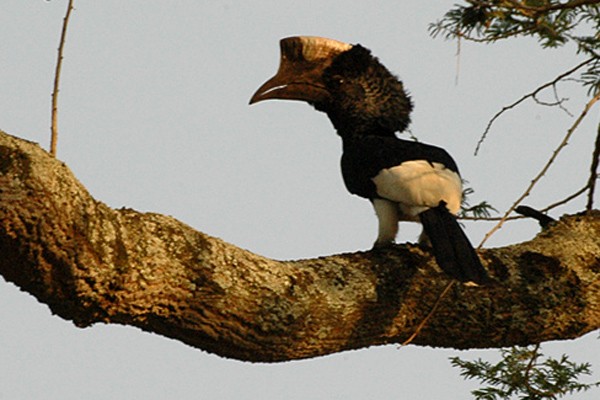Black-and-white-casqued Hornbill
A species of Black-and-white-casqued Hornbills and Allies, Also known as Grey-cheeked Hornbill Scientific name : Bycanistes subcylindricus Genus : Black-and-white-casqued Hornbills and Allies
Black-and-white-casqued Hornbill, A species of Black-and-white-casqued Hornbills and Allies
Also known as:
Grey-cheeked Hornbill
Botanical name: Bycanistes subcylindricus
Genus: Black-and-white-casqued Hornbills and Allies
Content
Description General Info
 Photo By Tom Tarrant , used under CC-BY-SA-3.0 /Cropped and compressed from original
Photo By Tom Tarrant , used under CC-BY-SA-3.0 /Cropped and compressed from original Description
Bycanistes subcylindricus is a moderately large bird of 60 to 70 cm with a wingspan of 28 to 38 cm. It is recognizable by its black plummage for the higher body and wings alongside and white plummage on the lower body and wings with black feathers amongst the white feathers of the tail, particularly the top tail feathers and the base of the tail feathers. It has a yellow-brownish bill and flattened casque, which are enlarged in males. Females have a smaller casque and a black bill. The purpose of the casque is unknown for males, although suggested to be for sexual characterization. The black-and-white-casqued hornbill has very mobile eyes which is not a common trait in birds. This means that its eyes themselves can move in their socket, while other birds tend to have to move their heads to see. It is capable of displaying emotions through the feathers at the top of the head, which allows it to communicate its emotional state. While males weight between 1 kg and 1.5 kg, the females weight between 1 kg and 1.25 kg. 
Size
70 cm
Nest Placement
Tree
Feeding Habits
Black-and-white-casqued Hornbill primarily feed on fruits, especially figs, and occasionally hunt small animals and bird eggs. They hydrate through fruit moisture, utilizing a skillful beak for delicate food handling.
Habitat
The black-and-white-casqued Hornbill predominantly inhabits areas characterized by dense forest ecosystems, particularly favoring ecotones where evergreen forest or forest patches border secondary forests. They are also known to thrive within tall deciduous woodlands and various types of plantations. While having an arboreal disposition, they are generally found at higher elevations, capable of residing up to 2600 meters above sea level. This species occupies broad geographical regions consisting of tropical zones with significant forest cover.
Dite type
Frugivorous
General Info
Feeding Habits
Bird food type

Fruit
Distribution Area
The black-and-white-casqued hornbill is found mostly in Ivory-Coast, with smaller populations in its surrounding countries for West-African populations. The Central-African populations are mostly in Uganda and Kenya as well as Cameroon with smaller populations in Gabon, Tanzania and Central Africa. They are tropical birds that live in regions with high amounts of forests and is rarely seen in on flat lands, especially due to its arboreal nature. 
Species Status
Not globally threatened.